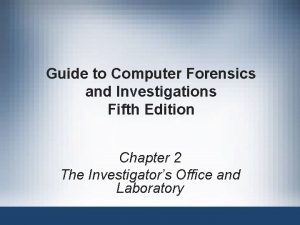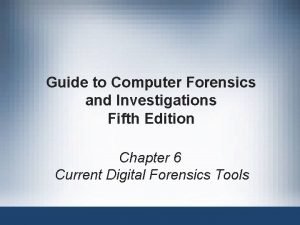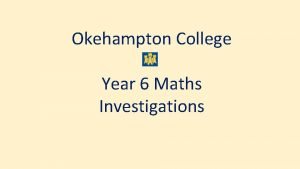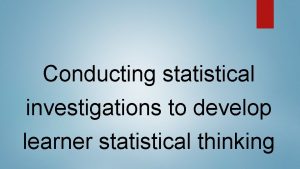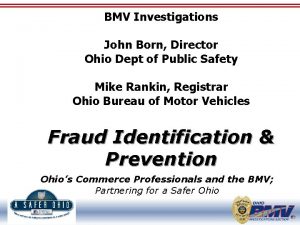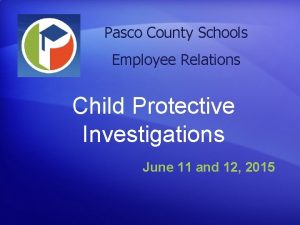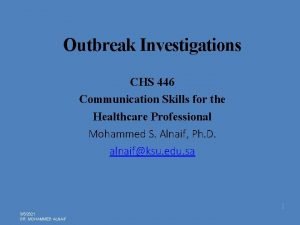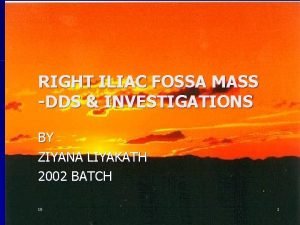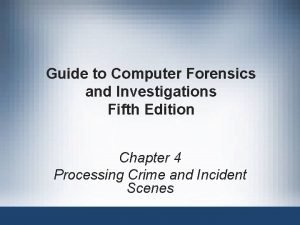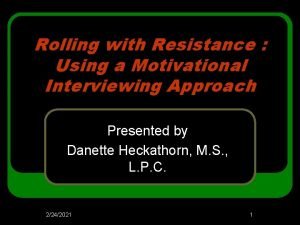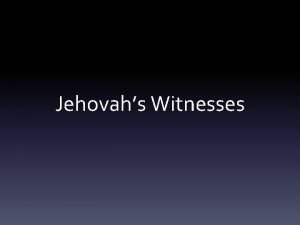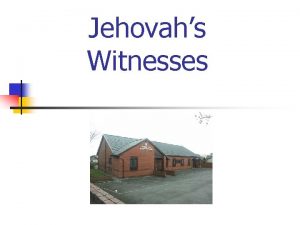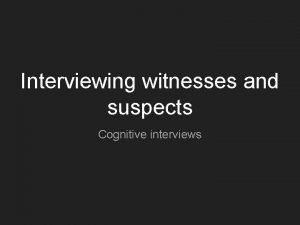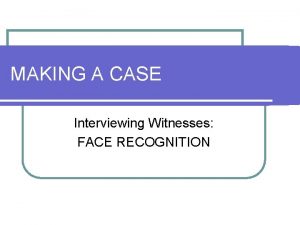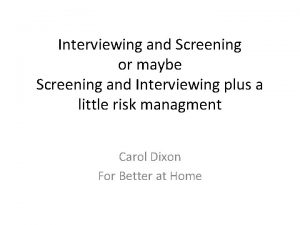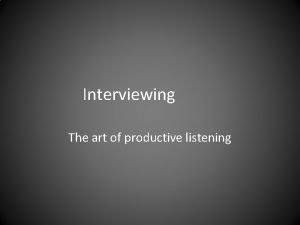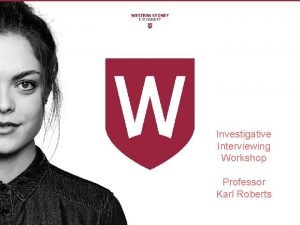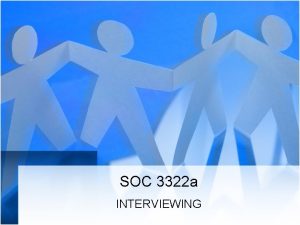PRELIMINARY INVESTIGATIONS AND INTERVIEWING WITNESSES Preliminary Investigations The



























- Slides: 27

PRELIMINARY INVESTIGATIONS AND INTERVIEWING WITNESSES

Preliminary Investigations: The Dispatchers Role � Begins when someone calls 911 to report a crime! � The 911 Dispatcher can have a great deal of impact on solving a crime if they obtain as much information as possible.

Preliminary Investigations: The Dispatchers Role � Dispatchers must get basic information first to provide officers with the information they need to make a safe approach to the scene, � but after they get this basic information about what has occurred, suspect information if available, and the presents of any weapons, the dispatcher should attempt to obtain the identity of the person calling and any other descriptive information about the suspect or mode of travel.

Preliminary Investigations: The Dispatchers Role � During a 9– 1– 1/emergency call—after obtaining preliminary information and dispatching police—the calltaker/dispatcher should— � Assure the caller the police are on the way. � Ask open-ended questions (e. g. , “What can you tell me about the car? ”) and augment with closed-ended questions (e. g. , “What color was the car? ”)

Preliminary Investigations: The Dispatchers Role � An open-ended question allows for an unlimited response from the witness in his/her own words (e. g. , “What can you tell me about the perpetrator? ” or “Tell me in your own words what happened. ”) � Although it is preferable to use open-ended questioning, the call-taker should follow with more directed questions if the caller is unresponsive to open-ended questions or provides imprecise responses.

Preliminary Investigations: The Dispatchers Role � Avoid asking suggestive or leading questions (e. g. , “Was the car red? ”). Leading questions suggest an answer and may distort the caller’s perception or memory. � Ask if anything else should be known about the incident. � Transmit information to responding officer(s). � Update officer(s) as more information comes in.

Preliminary Investigations Investigating the Scene � Caution Advised � Officers who first arrive at a possible crime scene must take care not to enter hastily. The crime scene may pose a threat to the officer: � an armed suspect may still be at the scene; � toxic chemicals or infectious materials may be present; � or evidence may be destroyed if the officer enters. � When practicable, officers shall first note the total environment of the scene including, for example, whether doors and windows are open or closed, lights on or off, presence of odors, and the condition and circumstances of the victim.

Preliminary Investigations Investigating the Scene �Principle: Preservation and documentation of the scene, including information from witnesses and physical evidence, are necessary for a thorough preliminary investigation. The methods used by the preliminary investigating officer have a direct impact on the amount and accuracy of the information obtained throughout the investigation.

Preliminary Investigations Investigating the Scene � Procedure: After forming an impression of the entire scene and ensuring that no threat exists, the officer shall proceed with the preliminary investigation which consists of, but is not limited to, the following activities: � 1. Providing aid to the injured.

Preliminary Investigations Investigating the Scene � 2. Defining the boundaries of and protect the crime scene to ensure that evidence is not lost or contaminated. �Erect barricade tape, rope, or cordon off the immediate crime scene. �Record any alterations to the crime scene because of emergency assistance, the immediate necessity to handle evidence, or the actions of witnesses, victims, or suspects at the scene.

Preliminary Investigations Investigating the Scene � 3. Determine if an offense has actually been committed and, if so, the exact nature of the offense. � 4. Determine the identity of the suspect or suspects and make an arrest if it can be accomplished either at the scene or through immediate pursuit. � 5. Furnish other officers with descriptions, method, and direction of flight of suspects, and other relevant information concerning wanted suspects or vehicles.

Preliminary Investigations Investigating the Scene � 6. Determine the identity of all witnesses. � Witnesses will need to be contacted later. � Obtain and document valid forms of identification and contact information for each witness. � List all witnesses in a written report. � 7. Separate witnesses and instruct them to avoid discussing details of the incident with other witnesses. �Witnesses should not hear others’ accounts because they may be influenced by that information. �Independent witness statements can corroborate other witnesses’ statements and other evidence in the investigation.

Preliminary Investigations Investigating the Scene � 8. Canvass area for other witnesses. �Witnesses may be reluctant to come forward for any number of reasons or may have departed the scene before law enforcement personnel arrived. �Also, other persons in the vicinity, such as neighbors or shopkeepers, may have heard or seen something that could assist in the investigation.

Preliminary Investigations Investigating the Scene � 9. Collect evidence. �Patrol officers who have been trained in collecting evidence will collect physical evidence to the limit of their ability and training. �When additional evidence requires collection, is beyond the capabilities or training of the officer, or is evidence in a serious crime, the patrol officer shall contact appropriate Crime Scene Investigation officers.

Preliminary Investigations Investigating the Scene � 10. Interview and obtain written statements from the victim, witnesses, and suspects. Check with dispatch personnel regarding any information provided during the original call from the scene. � 11. Arrange for follow-up surveillance of the crime scene, if appropriate. � 12. Accurately and completely record all pertinent information on the prescribed report forms.

Preliminary Investigations Investigating the Scene � Summary: The preliminary investigation at the scene forms a sound basis for the accurate collection of information and evidence during the follow-up investigation.

Preliminary Investigations: Interviewing Witnesses � Principle: The manner in which the preliminary investigating officer obtains information from a witness impacts the amount and accuracy of that information.

Preliminary Investigations: Interviewing Witnesses � Procedure: When interviewing a witness, the preliminary investigating officer should— �Establish rapport with the witness. �The development of rapport between the witness and investigator will make the witness more comfortable during the interview process. �Comfortable witnesses will generally provide more information. �In the course of developing rapport with the witness, the investigator can learn about the witness’s communication style (e. g. , how the witness describes everyday events compared with how the witness describes the incident).

Preliminary Investigations: Interviewing Witnesses � Inquire about the witness’s condition. �A simple question, such as “How are you doing? ” will not only contribute to rapport development, but it can alert the investigator to physical or mental conditions (e. g. , intoxication, medication, shock) that could potentially impair the witness’s ability to recall or report information effectively.

Preliminary Investigations: Interviewing Witnesses � Use open-ended questions (e. g. , “What can you tell me about the car? ”) and augment with closed-ended questions (e. g. , “What color was the car? ”). � Avoid leading questions (e. g. , “Was the car red? ”). � An open-ended question allows for an unlimited response from the witness in his/her own words (e. g. , “What can you tell me about the perpetrator? ” or “Tell me in your own words what happened”). � Open-ended questions allow the witness to play an active role, thereby generating a greater amount of unsolicited information. � Open-ended responses also tend to be more accurate and promote more effective listening on the part of the investigator. The investigator also is less likely to lead the witness when framing questions in this manner.

Preliminary Investigations: Interviewing Witnesses � A closed-ended question, in contrast, limits the amount or scope of information that the witness can provide (e. g. , “Did the perpetrator have a beard? ” or “What color was the car? ”). �Although it is preferable to use open-ended questioning, the investigator should follow with more directed questions if the witness is unresponsive to open-ended questions or provides imprecise responses. �If, for example, when answering an open-ended question, the witness states that the perpetrator was dressed in “shabby” clothing, the investigator should ask the witness to elaborate on the type of clothing (e. g. , “What do you mean by ‘shabby’? ”).

Preliminary Investigations: Interviewing Witnesses � For each new topic of information being sought, the investigator should begin with open-ended questions and augment them with closed-ended questions if necessary. � For example, if, after having elicited all information from the witness about the perpetrator, the next topic of information is the getaway car, the investigator should begin this line of inquiry with open-ended questions about the car.

Preliminary Investigations: Interviewing Witnesses � Leading questions suggest an answer and may distort the witness’s perception or memory. The investigator needs to determine only what the witness knows, uninfluenced by what the investigator might expect or know from other sources. � For example, the investigator may have been informed by another witness that the car was red, but should not ask, “Was it a red Honda? ”

Preliminary Investigations: Interviewing Witnesses � Clarify the information received with the witness. Asking the witness about what they have reported ensures that the information has been understood and accurately recorded. � Document information obtained from the witness, including the witness’s identity, in a written report. This information will be necessary when the witness is contacted for a follow-up interview.

Preliminary Investigations: Interviewing Witnesses � Encourage the witness to contact investigators with any further information. Witnesses will often remember additional, useful information after an interview. Remind the witness that any information, no matter how trivial it may seem, is important.

Preliminary Investigations: Interviewing Witnesses � Encourage the witness to avoid contact with the media or exposure to media accounts concerning the incident. � Media information may contaminate the witness’s memory. � Media requests for a story or offers of compensation may encourage a witness to fabricate information. � Instruct the witness to avoid discussing details of the incident with other potential witnesses. �Witnesses should not hear others’ accounts because they may be influenced by that information. �The independence of witnesses is important to see if the information they have provided is consistent with other witnesses’ statements and other evidence in the investigation.

Preliminary Investigations: Interviewing Witnesses � Summary: Information obtained from the witness can corroborate other evidence (e. g. , physical evidence, accounts provided by other witnesses) in the investigation. Therefore, it is important that this information be accurately documented in writing.
 Jehovah's witnesses armageddon 2034
Jehovah's witnesses armageddon 2034 Addiction medicine expert witness
Addiction medicine expert witness Marking bad clusters data hiding technique
Marking bad clusters data hiding technique Chapter 6 fingerprints
Chapter 6 fingerprints Forensics
Forensics Tasks performed by computer forensics tools
Tasks performed by computer forensics tools Why aren t descriptive investigations repeatable
Why aren t descriptive investigations repeatable Nrich maths investigations
Nrich maths investigations Craigslist private investigator
Craigslist private investigator Numerical datum crossword puzzle clue
Numerical datum crossword puzzle clue Statistical investigations examples
Statistical investigations examples Heatherdowns bmv
Heatherdowns bmv Observations in scientific method
Observations in scientific method Pasco county child protective services
Pasco county child protective services Chs investigations
Chs investigations Appendiculolith
Appendiculolith Jarrod bowditch
Jarrod bowditch Antenatal investigations
Antenatal investigations Investigations
Investigations Chs investigations
Chs investigations What is preliminary and fine grain screening?
What is preliminary and fine grain screening? Preliminary cooking and flavoring
Preliminary cooking and flavoring Examples of rolling with resistance
Examples of rolling with resistance Contoh motivational interviewing
Contoh motivational interviewing Motivational interviewing dears
Motivational interviewing dears Motivational interviewing schizophrenia
Motivational interviewing schizophrenia Motivational interviewing basics
Motivational interviewing basics Motivational interviewing dears
Motivational interviewing dears




